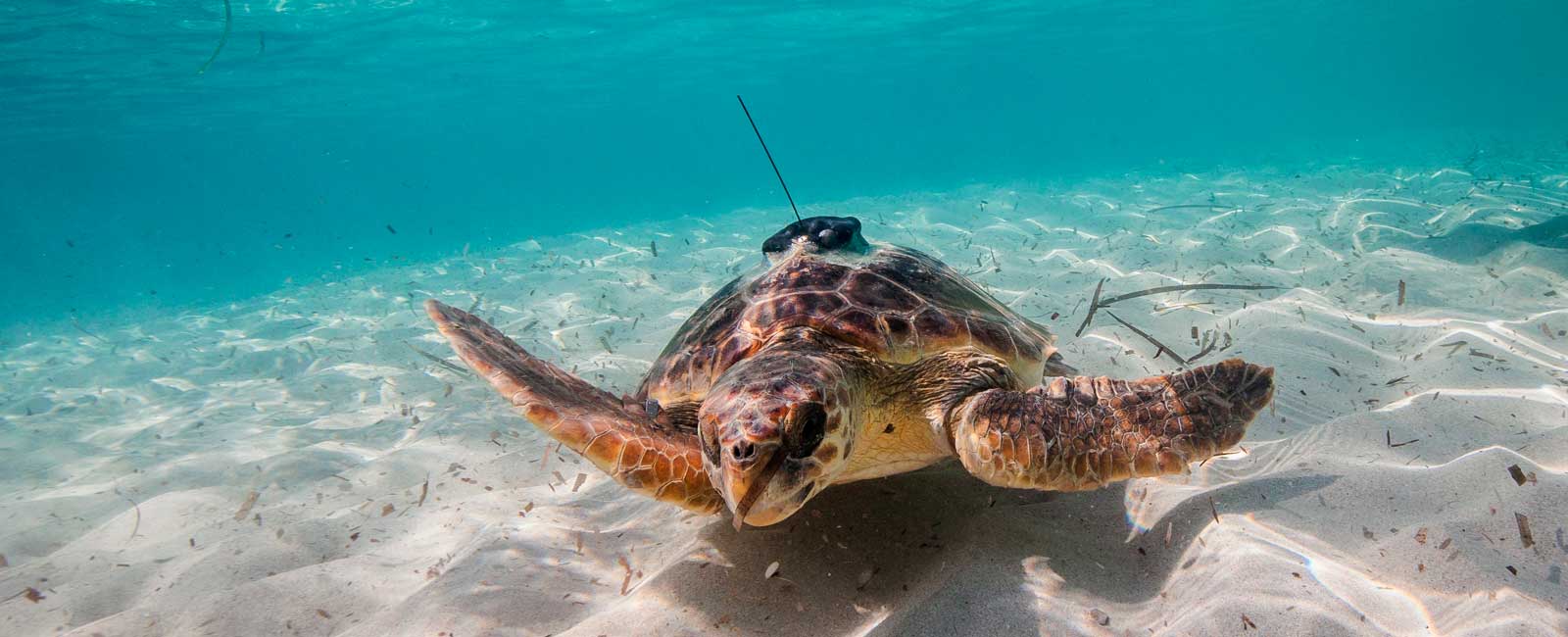
The voyage of the “oceanographer turtles’’
The project “Oceanographer Turtles”, involving the release of loggerhead turtles (Caretta caretta) fitted with satellite tags into Balearic Island waters, is an attempt at developing science-based techniques to mitigate the risks faced by these seagoing creatures. Led by the Balearic Islands Coastal Observing and Forecasting System (ICTS SOCIB), “Oceanographer Turtles” receives funding under the BBVA Foundation Grants for Scientific Research Teams in the Ecology and Conservation Biology area.
24 April, 2018
A bare twenty days from her release, Lasi – a female loggerhead – has traveled a distance of over 600 kilometers: from Mallorca’s S’Amarador de Santanyí beach to the Alicante Canyon. What is special about Lasi is that she has her own Twitter account, on which she “tweets” her position once a day thanks to a satellite tag affixed to her shell that permits real-time tracking of her movements.
The project’s principal investigator, David March, explains that Lasi was found by fishermen on 15 March off the island of Cabrera. The turtle was evidently struggling to dive underwater, so was transported to the Marine Rescue Center at Fundación Palma Aquarium, a partner organization in the project, where she spent three weeks being thoroughly checked out.
“She was perfectly healthy and had nothing wrong with her,” reported March on the phone, adding that she had probably been sunbathing to warm herself up. “Turtles depend on the outside temperature, so on sunny winter days they like to float on the surface for a while to raise their body heat. Anyone watching could easily imagine that they were in difficulties.”
Having confirmed that the animal was in good health, the team fitted the device on her shell before releasing her in a protected zone along Mallorca’s east coast with little shipping traffic. The tag relays her position to researchers once a day so they can monitor her progress. It also provides data on water temperatures and the depths to which the turtle has dived. “The plan now,” says March, “is to use this information to map the optimal zones for future turtle releases.”
Connecting Lasi’s tag to social network Twitter was, from the start, a part of the project, conceived as a means to raise the profile of the research. “It is a useful way for the public to stay informed about the work we are doing,” the scientist recounts.
Although Lasi was the last turtle to be released, she is not the only one that can be followed on Twitter. Cannoli, a male of the species, also spent time in the rescue center, and has been at sea now for 200 days, in which time he has covered over 5,000 kilometers. This particular specimen was retrieved from a tangle of fishing lines, bales of rope and plastic bottles.
March explains that before tagging began, the team had studied the historical routes of 80 turtles in that part of the Mediterranean. The task now is to compare this information with oceanographic data to gauge the effect it has on sea turtle distribution. “What we have learned so far,” he states, “is that a majority of Mediterranean turtles came originally from the Atlantic and remain in this area because of the characteristics of the water.”
Among the project’s other aims is to draw up risk maps that indicate the optimal zones for turtle release, meaning they also have to implement real-time monitoring of maritime traffic to and from the islands.
Sea turtle tagging has already thrown up some interesting data, with one specimen, for instance, registering depths of up to 250 meters. “This is a surprise finding,” the researcher notes, “because turtles spend most of their time at depths of between 20 and 30 meters.” And yet another turtle had crossed the Mediterranean to the Turkish coast in the space of ten months.
Although the International Union for Conservation of Nature (IUCN) affirms that Atlantic turtle populations are stable in the Mediterranean and have suffered no reduction in the past few years, there are a series of risks that these animals have to contend with. March singles out three: accidental capture in longline fishing – recently in decline, collisions with boats and getting caught in plastic.
Next up is the analytical part of the investigation. “We will continue to log the data coming in from Lasi and Cannoli in order to compare the turtles’ routes and dives with oceanographic variability, so we understand more about their behavior and mobility,” March remarks.
The ultimate aim, he concludes, is to construct a mathematical model that can provide probability maps for the species’ potential habitat. “Following that, we will match the data with those of shipping traffic and fishing grounds to identify where there is most risk of interaction.”
